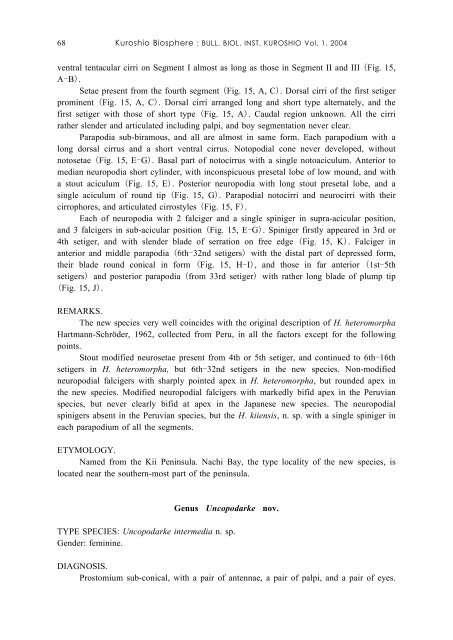HESIONIDAE (ANNELIDA, POLICHAETA) FROM JAPAN. I. by Hiro ...
HESIONIDAE (ANNELIDA, POLICHAETA) FROM JAPAN. I. by Hiro ...
HESIONIDAE (ANNELIDA, POLICHAETA) FROM JAPAN. I. by Hiro ...
You also want an ePaper? Increase the reach of your titles
YUMPU automatically turns print PDFs into web optimized ePapers that Google loves.
68 Kuroshio Biosphere : BULL. BIOL. INST. KUROSHIO Vol. 1, 2004<br />
ventral tentacular cirri on Segment I almost as long as those in Segment II and III (Fig. 15,<br />
A-B).<br />
Setae present from the fourth segment (Fig. 15, A, C). Dorsal cirri of the first setiger<br />
prominent (Fig. 15, A, C). Dorsal cirri arranged long and short type alternately, and the<br />
first setiger with those of short type (Fig. 15, A). Caudal region unknown. All the cirri<br />
rather slender and articulated including palpi, and boy segmentation never clear.<br />
Parapodia sub-biramous, and all are almost in same form. Each parapodium with a<br />
long dorsal cirrus and a short ventral cirrus. Notopodial cone never developed, without<br />
notosetae (Fig. 15, E-G). Basal part of notocirrus with a single notoaciculum. Anterior to<br />
median neuropodia short cylinder, with inconspicuous presetal lobe of low mound, and with<br />
a stout aciculum (Fig. 15, E). Posterior neuropodia with long stout presetal lobe, and a<br />
single aciculum of round tip (Fig. 15, G). Parapodial notocirri and neurocirri with their<br />
cirrophores, and articulated cirrostyles (Fig. 15, F).<br />
Each of neuropodia with 2 falciger and a single spiniger in supra-acicular position,<br />
and 3 falcigers in sub-acicular position (Fig. 15, E-G). Spiniger firstly appeared in 3rd or<br />
4th setiger, and with slender blade of serration on free edge (Fig. 15, K). Falciger in<br />
anterior and middle parapodia (6th-32nd setigers) with the distal part of depressed form,<br />
their blade round conical in form (Fig. 15, H-I), and those in far anterior (1st-5th<br />
setigers) and posterior parapodia (from 33rd setiger) with rather long blade of plump tip<br />
(Fig. 15, J).<br />
REMARKS.<br />
The new species very well coincides with the original description of H. heteromorpha<br />
Hartmann-Schröder, 1962, collected from Peru, in all the factors except for the following<br />
points.<br />
Stout modified neurosetae present from 4th or 5th setiger, and continued to 6th-16th<br />
setigers in H. heteromorpha, but 6th-32nd setigers in the new species. Non-modified<br />
neuropodial falcigers with sharply pointed apex in H. heteromorpha, but rounded apex in<br />
the new species. Modified neuropodial falcigers with markedly bifid apex in the Peruvian<br />
species, but never clearly bifid at apex in the Japanese new species. The neuropodial<br />
spinigers absent in the Peruvian species, but the H. kiiensis, n. sp. with a single spiniger in<br />
each parapodium of all the segments.<br />
ETYMOLOGY.<br />
Named from the Kii Peninsula. Nachi Bay, the type locality of the new species, is<br />
located near the southern-most part of the peninsula.<br />
Genus Uncopodarke nov.<br />
TYPE SPECIES: Uncopodarke intermedia n. sp.<br />
Gender: feminine.<br />
DIAGNOSIS.<br />
Prostomium sub-conical, with a pair of antennae, a pair of palpi, and a pair of eyes.


